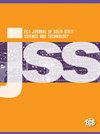Experimental Investigation on Chemical Mechanical Polishing of ZA27 Alloy Considering Galvanic Corrosion at Zn/Al Interface
IF 1.8
4区 材料科学
Q3 MATERIALS SCIENCE, MULTIDISCIPLINARY
ECS Journal of Solid State Science and Technology
Pub Date : 2024-07-08
DOI:10.1149/2162-8777/ad6033
引用次数: 0
Abstract
To improve the surface integrity of ZA27 alloy, a method of chemical mechanical polishing (CMP) considering the galvanic corrosion at the Zn/Al interface is proposed to treat the surface of ZA27 alloy. Firstly, the electrochemical experiment is carried out to study the influence of the pH, H2O2 concentration, and glycine concentration on corrosion potential between zinc and aluminum. Then the Taguchi method integrated with grey relation analysis and fuzzy inference are used to optimize the CMP parameters of ZA27 alloy. Finally, the prediction model of the MRR and surface roughness Ra is established using the mathematical regression analysis method. The experimental results showed that the minimum zinc-aluminum corrosion potential difference is 14 mV when the pH is 10, H2O2 concentration is 1 wt%, and glycine concentration is 0.4 wt%. The optimum CMP parameter is the polishing pressure of 34 kPa, the polishing plate's rotational speed of 70 rpm, and the abrasive particle concentration of 15 wt%. After polishing with the optimum CMP parameter, the MRR is 242 nm/min, and the surface roughness Ra is 13.91 nm. This study demonstrates that the CMP considering the galvanic corrosion at the Zn/Al interface is an effective method for treating ZA27 alloy surface.考虑锌/铝界面电化学腐蚀的ZA27 合金化学机械抛光实验研究
为了提高ZA27 合金的表面完整性,考虑到锌/铝界面的电化学腐蚀,提出了一种化学机械抛光(CMP)方法来处理ZA27 合金的表面。首先进行电化学实验,研究 pH 值、H2O2 浓度和甘氨酸浓度对锌铝之间腐蚀电位的影响。然后采用田口方法结合灰色关系分析和模糊推理优化了ZA27 合金的 CMP 参数。最后,利用数学回归分析方法建立了 MRR 和表面粗糙度 Ra 的预测模型。实验结果表明,当 pH 值为 10、H2O2 浓度为 1 wt%、甘氨酸浓度为 0.4 wt% 时,最小锌铝腐蚀电位差为 14 mV。最佳 CMP 参数为抛光压力 34 kPa、抛光板转速 70 rpm 和磨料颗粒浓度 15 wt%。采用最佳 CMP 参数抛光后,MRR 为 242 nm/min,表面粗糙度 Ra 为 13.91 nm。这项研究表明,考虑到 Zn/Al 界面的电化学腐蚀,CMP 是处理 ZA27 合金表面的一种有效方法。
本文章由计算机程序翻译,如有差异,请以英文原文为准。
求助全文
约1分钟内获得全文
求助全文
来源期刊

ECS Journal of Solid State Science and Technology
MATERIALS SCIENCE, MULTIDISCIPLINARY-PHYSICS, APPLIED
CiteScore
4.50
自引率
13.60%
发文量
455
期刊介绍:
The ECS Journal of Solid State Science and Technology (JSS) was launched in 2012, and publishes outstanding research covering fundamental and applied areas of solid state science and technology, including experimental and theoretical aspects of the chemistry and physics of materials and devices.
JSS has five topical interest areas:
carbon nanostructures and devices
dielectric science and materials
electronic materials and processing
electronic and photonic devices and systems
luminescence and display materials, devices and processing.
文献相关原料
| 公司名称 | 产品信息 | 采购帮参考价格 |
|---|
 求助内容:
求助内容: 应助结果提醒方式:
应助结果提醒方式:


